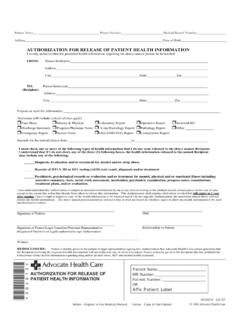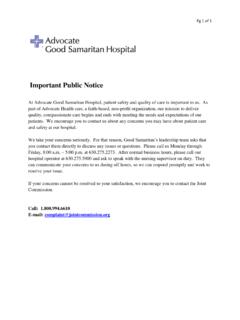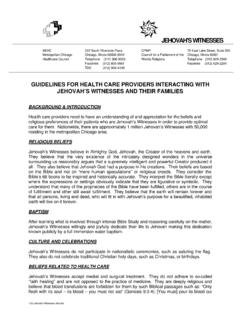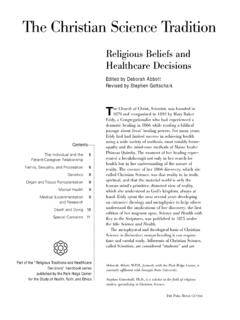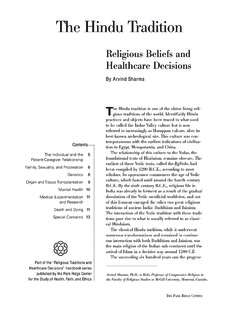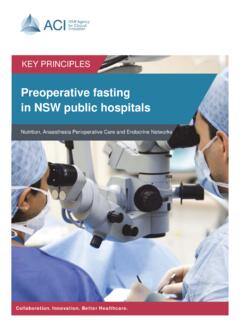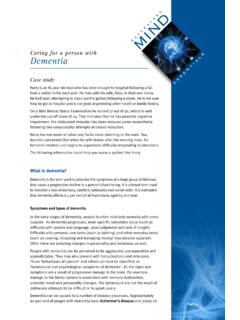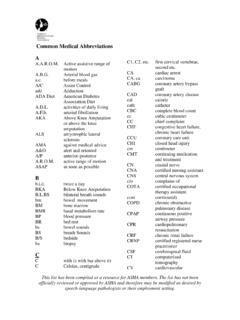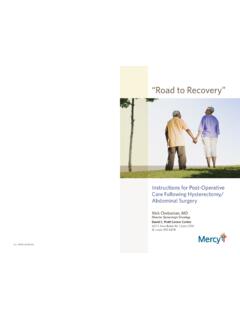Transcription of PRE-ANESTHESIA EVALUATION GUIDELINES
1 PRE-ANESTHESIA EVALUATION GUIDELINES . GUIDELINES developed by Divyang R. Joshi, MD. Original endorsed by: Advocate Safer Surgery Council October 2010. Revised by: Advocate Safer Surgery Council and Clinical Effectiveness Laboratory Committee, March 2016. Next revision due March 2018. This document was assembled using information from various sources which are referenced at the end. This document was created as a tool to be used for the preoperative EVALUATION of the surgical patient based on the best evidence available as of 2016; it is not intended to supersede the judgment and recommendations of the individual patient's physicians. For more information please contact: Advocate BroMenn Medical Center Advocate Good Shepherd Hospital Telephone: Telephone: Facsimile: Facsimile: Advocate Illinois Masonic Medical Center Advocate Christ Medical Center Telephone: Telephone: Facsimile: Facsimile: Advocate Lutheran Hospital Advocate Lutheran General Children's Hospital Advocate Condell Medical Center Telephone: 847-723-8121.
2 Telephone: Facsimile: Facsimile: Advocate Sherman Hospital Advocate Eureka Hospital Surgery Scheduling: Telephone: PAT: Facsimile: Advocate South Suburban Hospital Telephone: Advocate Good Samaritan Hospital Facsimile: Telephone: Advocate Trinity Hospital Facsimile: Telephone: Facsimile: 00-8473 3/16. Purpose and Background .. 3. Section I: GUIDELINES for Primary Care Physicians GUIDELINES Based on Procedure .. 4. GUIDELINES Based on Medical History .. 5. Medications to Discontinue Prior to Surgery .. 7. GUIDELINES for Preoperative Fasting .. 9. GUIDELINES for Cardiac EVALUATION .. 10. ASA/Plavix (Clopidogrel) .. 16. Sleep 17. Section II: GUIDELINES for Patients GUIDELINES for Preoperative Smoking Cessation .. 7. GUIDELINES for Preoperative Fasting .. 8. Appendix.
3 20. 2. Use of these GUIDELINES may help avoid routine preoperative testing and direct the preoperative EVALUATION using an evidence-based methodology. They are intended to facilitate and provide a best evidence basis for preoperative testing. This should help avoid both delays on the day of surgery and unnecessary cost, while still providing an appropriate workup for the patient presenting for surgery. The information within this document is a compilation of the best evidence available as well as societal GUIDELINES and expert opinions when evidence is not conclusive or lacking. A list of valuable references (used to prepare this document) is provided at the end where further details may be obtained. Background Routine preoperative testing Numerous studies show that there is a lack of an association between patient benefit and routine testing.
4 On average, 1/2000 preoperative tests lead to patient harm secondary to the further investigation warranted by an abnormal result. On the other hand, only 1/10,000 preoperative tests is actually of benefit to the patient. In a multivariate regression analysis done to determine what risk factors are associated with an adverse outcome, the only two factors consistently found to have such an association were: 1. ASA PS 3 or greater 2. The risk of surgery as classified by the ACC/AHA GUIDELINES . Age alone is not an indication for any test and tests therefore should be based on the coexisting diseases and invasiveness of the procedure to be performed. Laboratory results within 3 months are generally acceptable (unless major abnormalities are present or the patient's medical condition has changed).
5 3. SECTION I: GUIDELINES for Primary Care Physicians Testing GUIDELINES Based on the Procedure Low Risk Procedures These are procedures in which the combined incidence of perioperative MI or death is less than 1%. Ambulatory Surgery Arthroscopy, diagnostic NO ROUTINE LAB TESTS. Breast surgery Lab tests as indicated by the Cataract Surgery If diabetic, obtain Accu-Chek(R) glucose. patient's medical history If concerned by medical history, refer to **Only exception would be a baseline Cr PCP for clearance. level in a patient undergoing a procedure Endoscopies involving injection of contrast dye. Superficial procedures Intermediate Risk Procedures These are procedures in which the combined incidence of perioperative MI or death is 1 5%. These are procedures in which blood loss or hemodynamic changes are rare.
6 AAA Repair, Endoscopic Carotid Endarterectomy NO ROUTINE LAB TESTS. Head & Neck procedures Lab tests as indicated by the patient's medical history Intraperitoneal or Intrathoracic procedures **Only exception would be a baseline Cr level in a patient Orthopedic procedures undergoing a procedure involving injection of contrast dye. Prostate surgery Vascular, Renal Risk* or Emergent Procedures These are procedures in which the combined incidence of perioperative MI or death is > 5%. These procedures disrupt normal physiology, commonly require blood transfusions, invasive monitoring, and postoperative ICU care. *A patient is at renal risk if they are having surgery for obstructive jaundice, major vascular, or procedures > 3hr Anticipated prolonged surgery with large fluid shifts &/or blood loss RECOMMENDED LAB TESTS.
7 Aortic, Cardiac, Major Vascular CBC with platelets Emergency CMP. Clearly, lab tests may not be obtainable in procedures ECG. emergency procedures and should only be Other lab tests as indicated by the patient's performed if time allows. medical history. Obstructive jaundice procedures 4. SECTION I: GUIDELINES for Primary Care Physicians Recommended Labs Based on Medical History Communicate any acute change in medical condition to the primary care or referring physician. Utility of Existing Lab Tests Laboratory results are good for 3 MONTHS unless abnormal Electrocardiograms are good for 6 MONTHS. CXR good for 6 MONTHS unless acute or active process if normal. 3 MONTHS if abnormal or if: +CAD. Risk Factors, known CAD or change in Stop NSAIDS/Cox 2 Inhibitors as soon as possible condition CBC/ PT/ Chem T&S Glu 7 LFTs TFTs ECG CXR U/A HCG ALB (Hgb Plt PTT A1c)2.
8 DISEASE. Alcohol Abuse 2 drinks/day X X X. Anemia X. Bleeding Hx X X. CV Disease4 X X X1. Cerebrovascular Dx X X X. Diabetes X X X. Hepatic Disease X X X X. 3X5 Recommend Pulmonary Malignancy X Clearance Malnutrition X. Morbid Obesity X X X. PVD X X. Poor Exercise Tolerance X X. Possible Pregnancy X3. 1X1 Recommend Pulmonary Pulmonary Dx Clearance Renal Disease X X X. 1X1. Rheumatoid Arthritis X X. Sleep Apnea (age >18 yrs.) X. 1X1 Recommend Pulmonary Smoking >20pk yr (in last yr) X X Clearance Suspected UTI X. 1X1. Systemic Lupus X X. Thyroid Disease X 9 Not to be drawn on arrival for surgery X. 1. For active, acute processes only (changed within the last 6 months?). 2. Studies do not uniformly support using HbA1c as a predictor of risk for postoperative complications 3.
9 HCG must be within 24 hours of surgery 4. CV disease includes: CAD, CHF, dyspnea, chest pain, palpitations, tachycardia, irregular HR, unexplained bradycardia, undiagnosed murmur, S3, ICD, pacemaker, pulmonary hypertension, syncope 5. If malignancy is within the thorax 6. If Radiation is to thorax, chest, breast or lungs 7. Must take NSAIDs/Cox 2 three or more times a week 8. Renal risk: If having high risk procedure see above and has HTN, DM, eGFR < 45, takes ACE Inhibitors, ARBS, or Diuretics 9. TSH within the last 6 months is acceptable 10. Missed AB requires H & H and T & RH, and Rhogam studies for RH negative patients (Continued on next page). 5. SECTION I: GUIDELINES for Primary Care Physicians Recommended Labs Based on Medical History Utility of Existing Lab Tests Laboratory results are good for 3 MONTHS unless abnormal Electrocardiograms are good for 6 MONTHS.
10 CXR good for 6 MONTHS unless acute or active process if normal. 3 MONTHS if abnormal or if: +CAD. Risk Factors, known CAD or change in Stop NSAIDS/Cox 2 Inhibitors as soon as possible condition CBC/ PT/ Che T&S Glu LFTs TFTs ECG CXR U/A HCG ALB IVF. Plt PTT m7. MEDICATION. Amiodarone X. Anticoagulants X X. Anticonvulsants (in last 6 mo.) Check level if seizures are poorly controlled Digoxin X X. Diuretics X. Immunosuppressent/. X. Chemotherapy NSAIDs/Cox 27 X. Radiation Therapy X X X6. Steroids (chronic use) X. Theophylline Check level if patient is wheezing Thyroid Replacement X9 Not to be drawn on arrival for surgery PROCEDURE. EBL > 500 ml (total joints, head X X. and neck, carotid endarterectomy, AAA, intraperitoneal or thoracic, spinal fusions, prostate surgery).
